How to Write a Cold Email That Converts (Without Being Pushy)
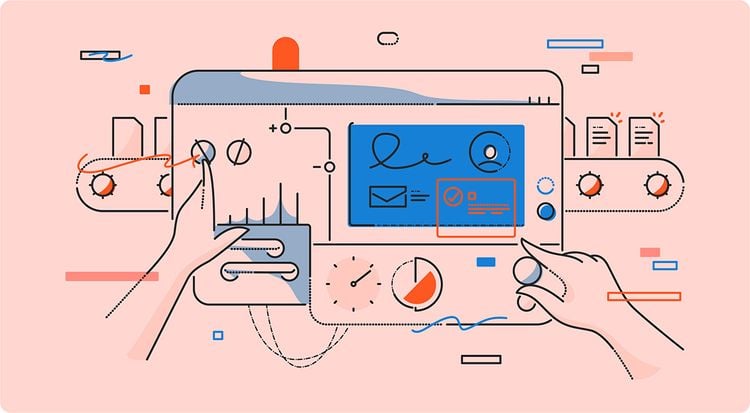
While launching a cold email campaign, your main goal should be to get a response from your prospect.
However, it’s not as easy a task as it seems. Every day we receive so many emails from both people we know and those we’ve never heard about, so it’s almost impossible to answer everyone.
Your email copy plays a crucial role when it comes to whether you get a response or not when cold emailing.
In this guide, we collected the most effective tips and examples that will help you write cold emails that convert and initiate conversations with your prospects.
Don’t have time to read the whole blog post? Download a quick checklist and start implementing tips that will help you boost your response rates immediately.
1. Create the perfect subject line
No one will ever respond to your cold email campaigns if no one opens your emails in the first place due to a poorly written subject line. So the first thing to do while working on a new cold email is to create the perfect subject line.
Make your subject line personal
Besides mentioning the first name and company name in the subject line, try to think of things you may have in common with your prospect. For example, common connections, the place you met, a conference you both attended, etc.
Adding a personal touch is your best bet in getting engagement for your cold emails.
Keep it short
It’s much easier to catch a prospect's attention with something short, sweet, and straight to the point. Short cold email subject lines also invoke curiosity.
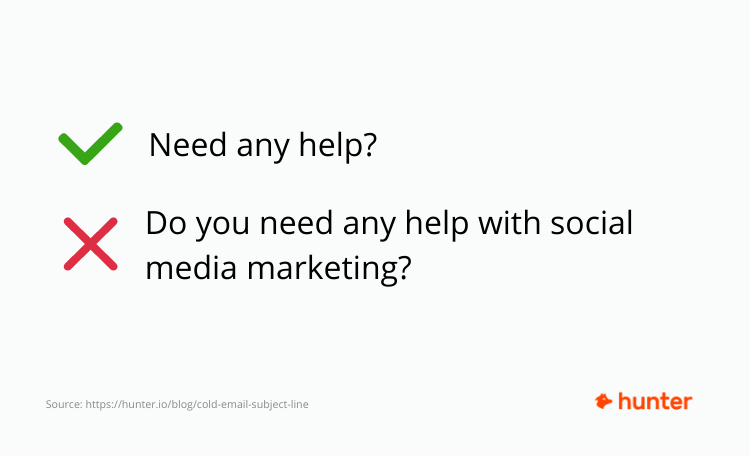
Ask questions
Questions are a great way to spark interest and entice prospects to open your email.
If you ask a question relevant to your prospects in the subject line, they're more likely to open your email and start looking for the answer.
2. Start with an outline
It’s quite apparent that you need to write an outline when working on a blog post, book, or guide. However, for smaller pieces of content, outlines are often ignored.
Outlines are needed for having a better structure to any content you write. Even if you have just a couple of sentences in your email, try to think of the one goal you want to achieve with your email, the question you want to ask, and the catchy introduction to make the user read your email.
And only then start writing your cold email.
Let’s take a look at this cold email I recently sent to build links for our blog post:
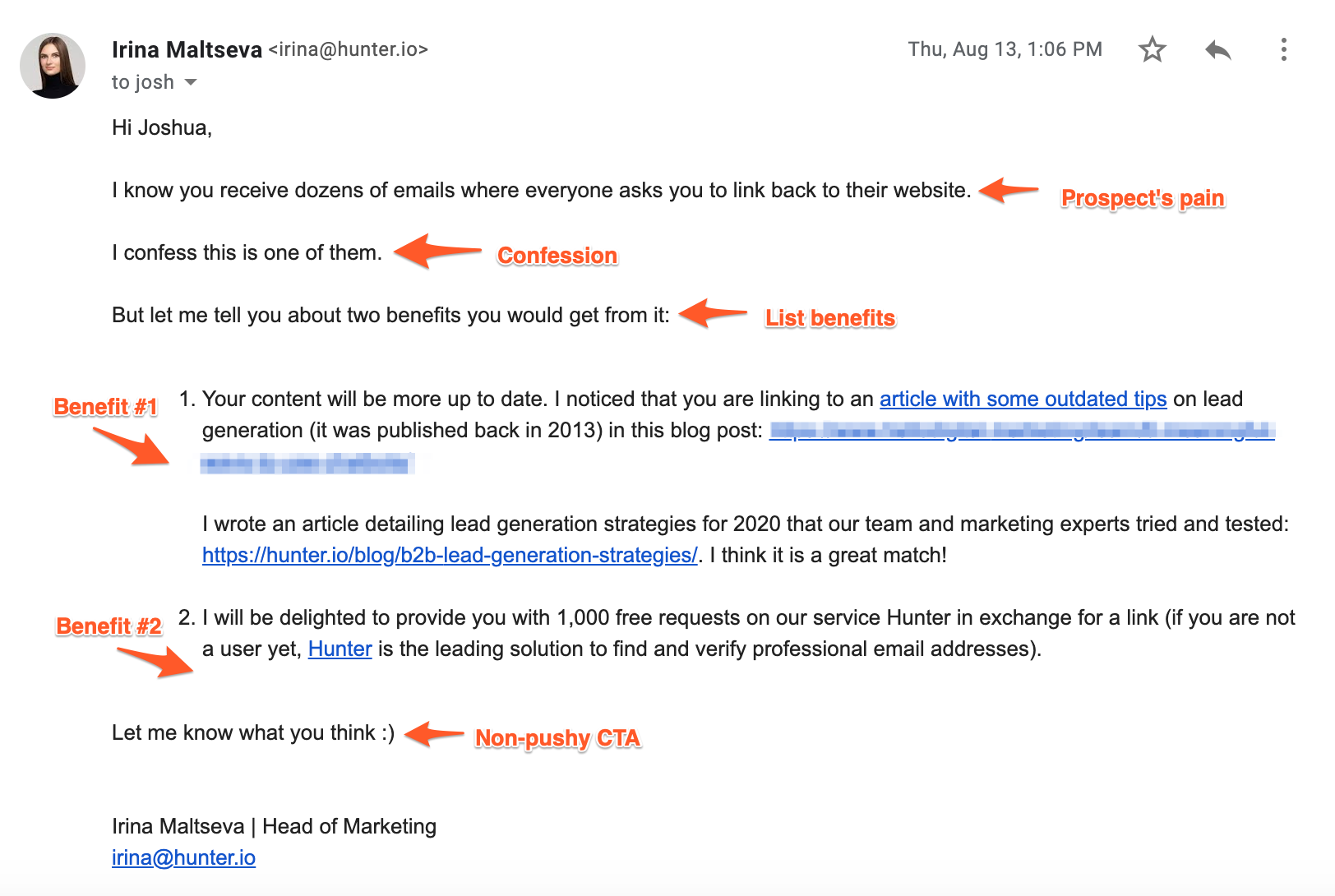
Before writing this email, I wrote a short outline that allowed me to better structure the message (and later get a 19.6% response rate). Here is how it looked:
- Mention prospect’s pain (they receive a lot of emails where everyone asks for a backlink);
- Confess that I’m asking for it as well;
- List two benefits prospects get by linking back to our content:
- our content is more up-to-date;
- provide a benefit for the time/efforts they invest in updating the old link;
- Add not-too-pushy CTA.
3. Write a catchy opening line
After the subject line, the opening line is the second most crucial sentence in your cold email.
You wrote a successful subject line and made prospects open your email. The next step would be to make them read your message.
If you start with something vague, dull, and not personalized, the chances are that you’ll never get a response from your prospect.
I recommend polishing your opening line to make your prospects interested in learning more about what you have to offer.
Try doing one of these things in your opening line:
- Ask a question
- Mention a mutual connection
- Share excitement or a compliment about their work
- Start with your prospects’ problem or pain point
- Use a recent trigger event
This email I recently received would be a great example of using a compliment about the work in the opening line:
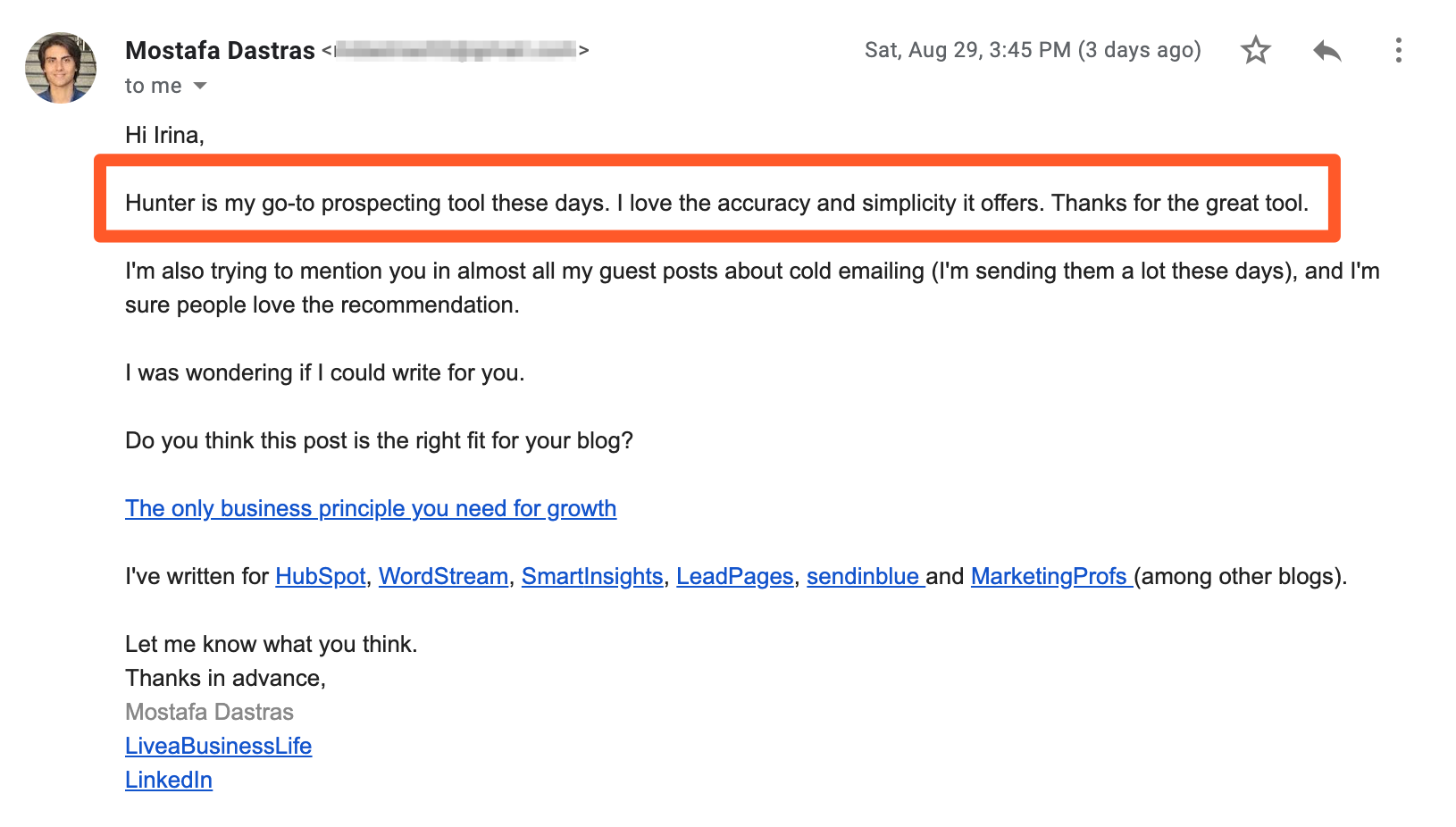
Besides having a catchy subject line (“Writing for my favorite email tool”), from the first line, Mostafa Dastras made me read his highly-personalized email and respond to him.
4. Personalize your message
Personalization is crucial when it comes to creating a great cold email. The more personal your cold email is, the more likely you are to get a response.
Generally, there are two key ways to personalize cold emails:
1. If you're sending a small batch of cold emails
It makes sense to spend time on high-value prospects and manually add a personal touch to every email you send.
You can create a single template for the outreach but add very specific information for each of your prospects to make the message relevant to them and provide maximum value.
A great example of such personalization is an email I received from HubSpot’s Growth Specialist Adam Toothaker.
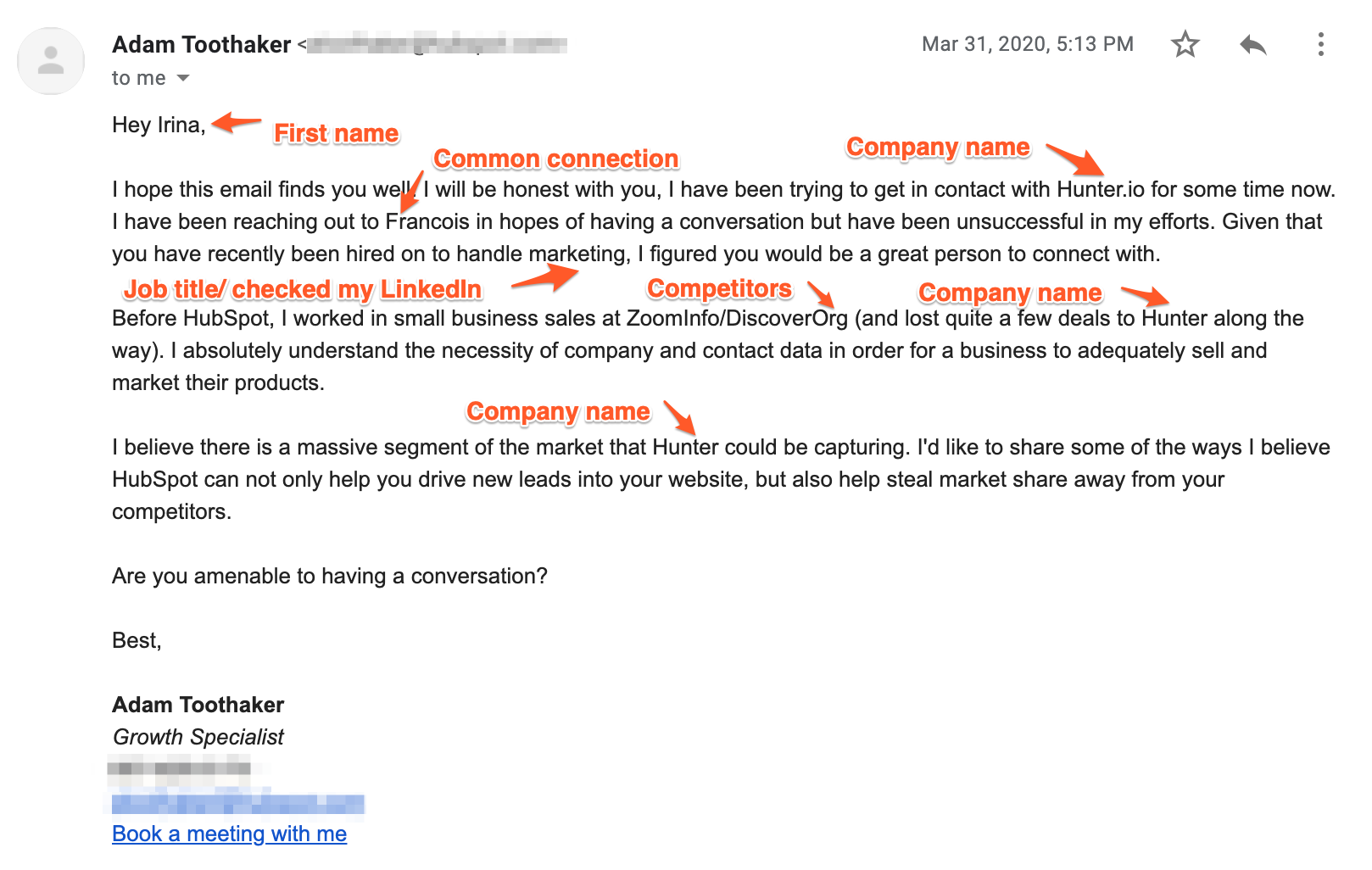
This email is great because it’s not another nonpersonal spammy message where someone only wants to sell you something.
Adam did a lot of work by conducting such in-depth research and showed me that he's interested in a genuine, mutually beneficial business relationship. Besides including essential personalization, he made the email personal by:
- Mentioning a common connection (he previously talked to Hunter’s co-founder François);
- Checking my LinkedIn profile and noticed that I just started handling marketing at Hunter (so he decided to reach out to us one more time using a different angle);
- Mentioned companies he's worked with in the past (they are very relevant to our product and have some features that intersect);
- Found a possible pain point (drive more leads to our website).
This is how you turn cold leads into warm ones.
Explore more highly-personalized cold email templates
2. If you're sending a large number of cold emails
For bigger email volumes, it’s not always possible to manually edit all of the emails since that can take a lot of time.
Fortunately, cold email software like Hunter Campaigns can help you save time preparing and scheduling highly-personalized emails.
All you need to do is to create a .CSV file with detailed information about your prospects.

Then, upload it to Hunter Leads (a simple CRM tool that allows you to structure information about your prospects).
Note: If you use Hunter to find your prospects’ email addresses, there is no need to create a .CSV file—you can save this info directly to Leads.
Then, Hunter Campaigns will use the data to personalize your cold emails in bulk automatically.
5. Keep it short and easy
As Sleeknote discovered, emails with shorter copy of 95 words significantly outperformed emails with longer copy of 170 words. In fact, shorter emails had a 5.81 percent higher CTR. That’s significant!
There are three key elements your cold email should contain:
- Who you are
- What your offer is
- The action you want the prospect to take
Try to eliminate unnecessary greetings like “I hope you’re doing well.” Being polite is a must, but it could be easily achieved by using the right style for your email.
Also, don’t use wordy sentences. Give your writing a confidence boost by eliminating words that make you sound uncertain and focusing on using plain language.
Here's a good example of a short and straight-to-the point email I received from G2 Crowd:
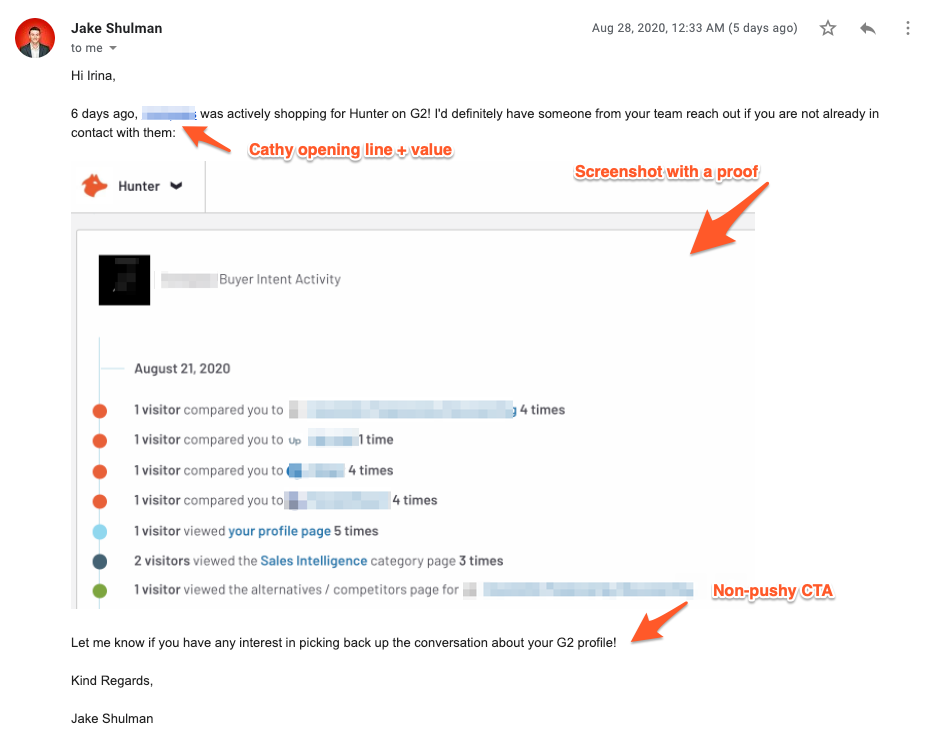
This is one of the shortest and most effective cold emails I've ever received:
- Jake starts with the value in the opening line (a potential lead for Hunter was actively shopping on G2)
- He confirms it with a screenshot from G2’s account (no words needed to describe that we might get a few new warm leads)
- He finishes his cold email with a non-pushy CTA (offering to continue a conversation on getting new leads from G2)
6. Provide value
Some companies think that if they have a specific service or product, they can just drop a few lines describing it and get a customer. Unfortunately, it doesn’t work this way.
It’s better not to send any sales pitches in the first email but rather try to offer a solution for the problem your prospects may have or show how your product or service can improve their business or life.
While writing your cold email, talk about the benefits prospects will get, not the features you sell.
To make your email even more convincing, be very precise with the benefits you're talking about. For example, there’s a huge difference between describing software that “saves a lot of time” and software that “saves 10 hours of your time weekly.”
One of the best examples of a cold email providing value was shared by Daryl Rosser on Ahrefs blog:
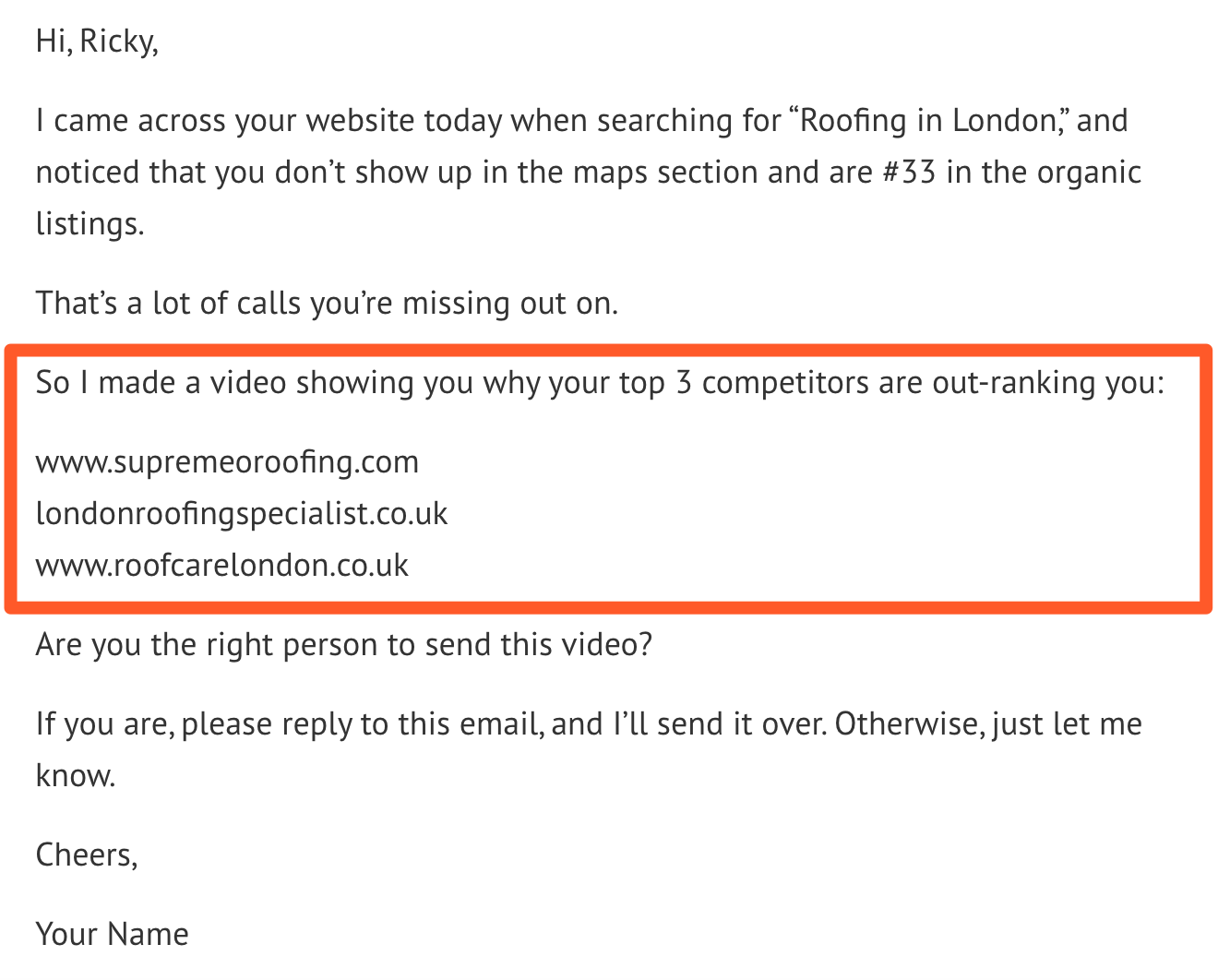
Daryl used this email to pitch his SEO services to potential clients. Besides creating a highly-personalized email, he focuses on what the client really wants.
He's not telling prospects about his on-page SEO ability or how great he is at building links. Daryl focuses on what they care about—getting prospects on a sales call.
Another essential element in his email is that he's not directly selling his services. Daryl is not asking prospects to get on the phone with him or buy anything at all. All they need to do is to respond by saying “yes, send me the video.”
7. Include a CTA
Setting the right CTA (call-to-action) is the key to boosting your reply rates. This is the part of your cold email that persuades prospects to take action—send a reply, click the link, submit a form, etc.
The CTA should have a perfect match with the goal of your cold email. Try to focus on a single thing you want to achieve with your cold email outreach. It’s definitely easier to achieve your goal by including one CTA rather than asking your prospect for too much. Optionally, you can incorporate a CTA into your email signature, giving your cold email a personal touch and making it less pushy.
Also, try to be very precise and specific with your CTA. I receive quite a lot of emails offering to “have a call and see what we can do together.” The chances are that prospects (like I do) just decide not to lose time on a vague offer where they don’t see any value.
Depending on the goal of your cold email, you can use similar CTAs:
- What are the next steps on your end?
- Are you still interested in {{your_offer}}?
- Will this work for you?
- Can you please put me in touch with the right person?
- Is this a priority issue you want to resolve?
- Do you mind if I share {{your_research}} how we can help you reach {{business_goal}}?
8. Write like a human
Even if you decide to automate your cold outreach fully, make it look like your prospect is receiving an email from a real human being.
For that, your first step would be to do your research and make the email personal.
The second step—write an email using simple and clear language. The main goal would be to make your prospects feel like they're talking to a friend or someone they’ve known for a long time.
Here's a great example of a casual, informal email from Noah Cagan:
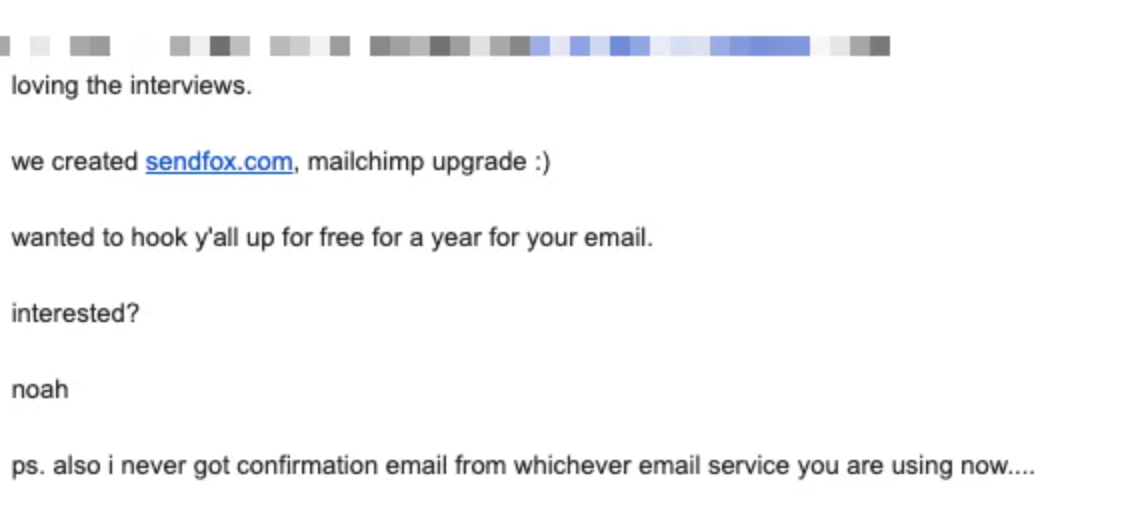
Besides that, don’t use HTML templates for your cold emails. Even if they look good and clean, it’s a clear signal to your prospects that they're a part of an automated sequence. Moreover, this might decrease your deliverability rate—quite often, emails land in the “Promotions” or “Spam” folders.
Using plain text in cold emails would be your best bet for making it look human and improving deliverability rates.
9. Make your email scannable
If you want prospects to read your cold email till the very end, avoid giant walls of text.
Here's an example of what I’m talking about:
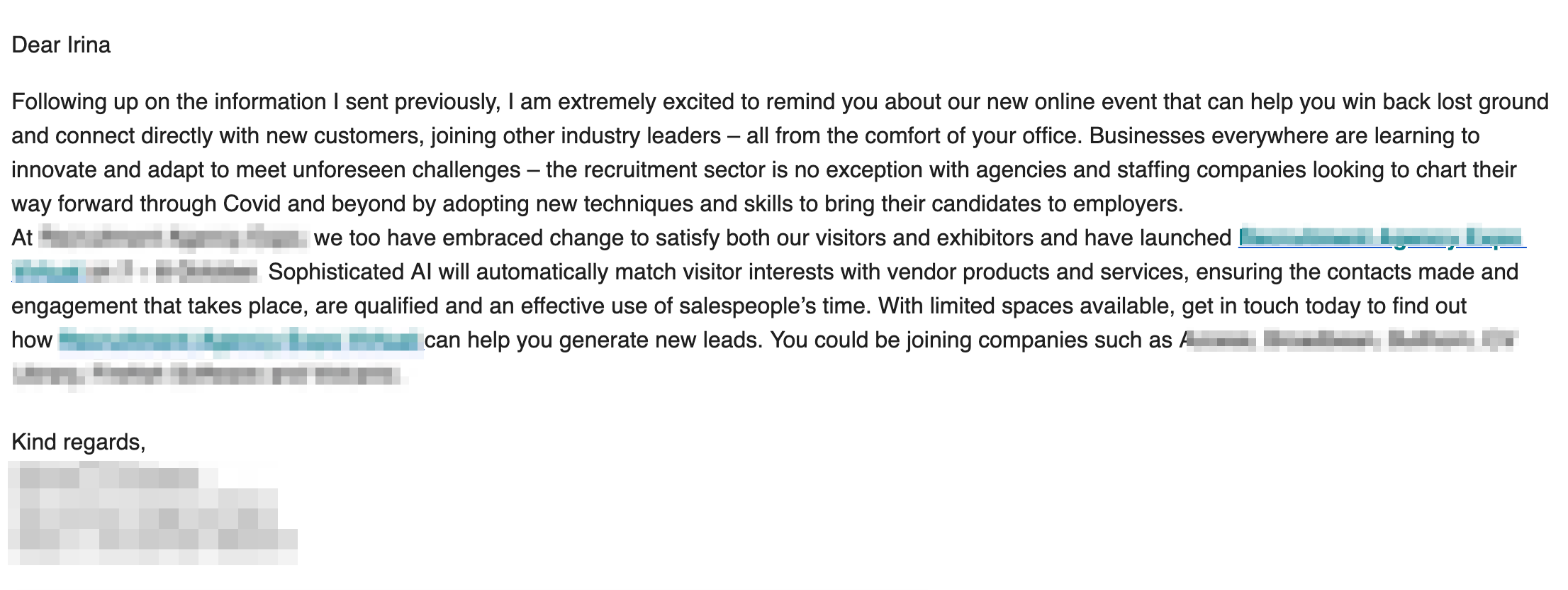
Instead, stick to short paragraphs that are 1–2 sentences long, incorporate breaks, lists, and nice formatting.
Formatted emails are easier to read, especially on mobile devices. Here's an example:
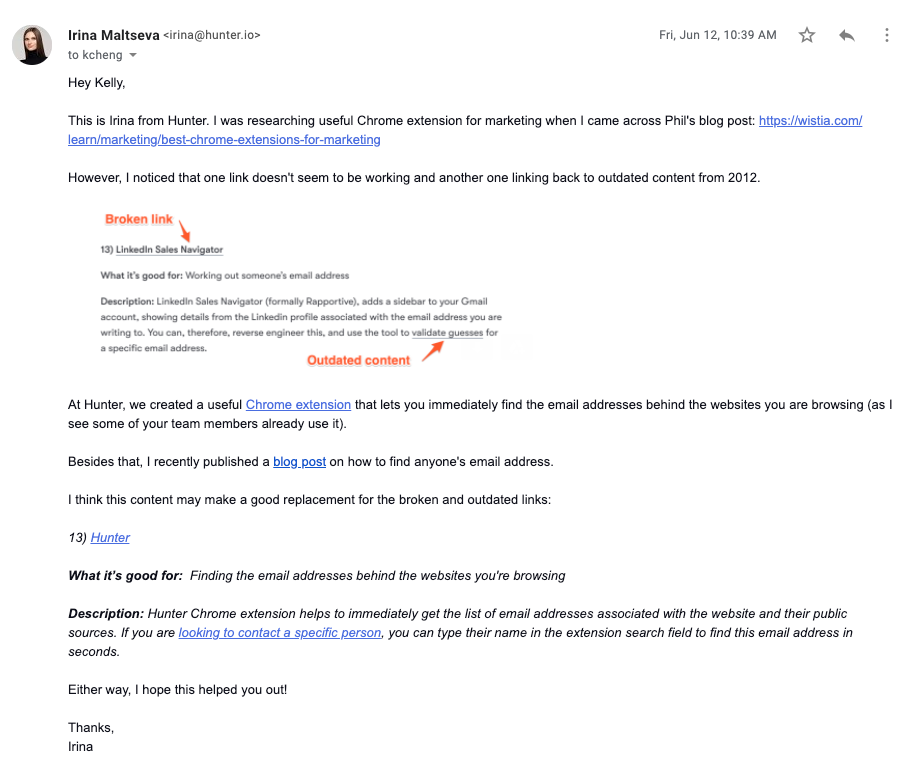
This email is a bit long for cold outreach, so to make it more scannable, I:
- Used short, one-sentence paragraphs;
- Added hyperlinks to illustrate the webpages to which I refer;
- Inserted an image with highlighted explanations of the things that could be improved;
- Italicized the part I wanted my prospect to change in their article;
- Bolded the main parts of the content I offer to replace.
Automate your cold outreach
After you find your prospects’ email addresses, it’s time to set up your cold email campaign. Here's how to do this with Hunter Campaigns:
1. Connect Hunter to your email account
Start by connecting Hunter to your email account to start sending emails to existing leads or new emails found.

2. Compose your message
Write the first message of your campaign or choose one from previously saved cold email templates.
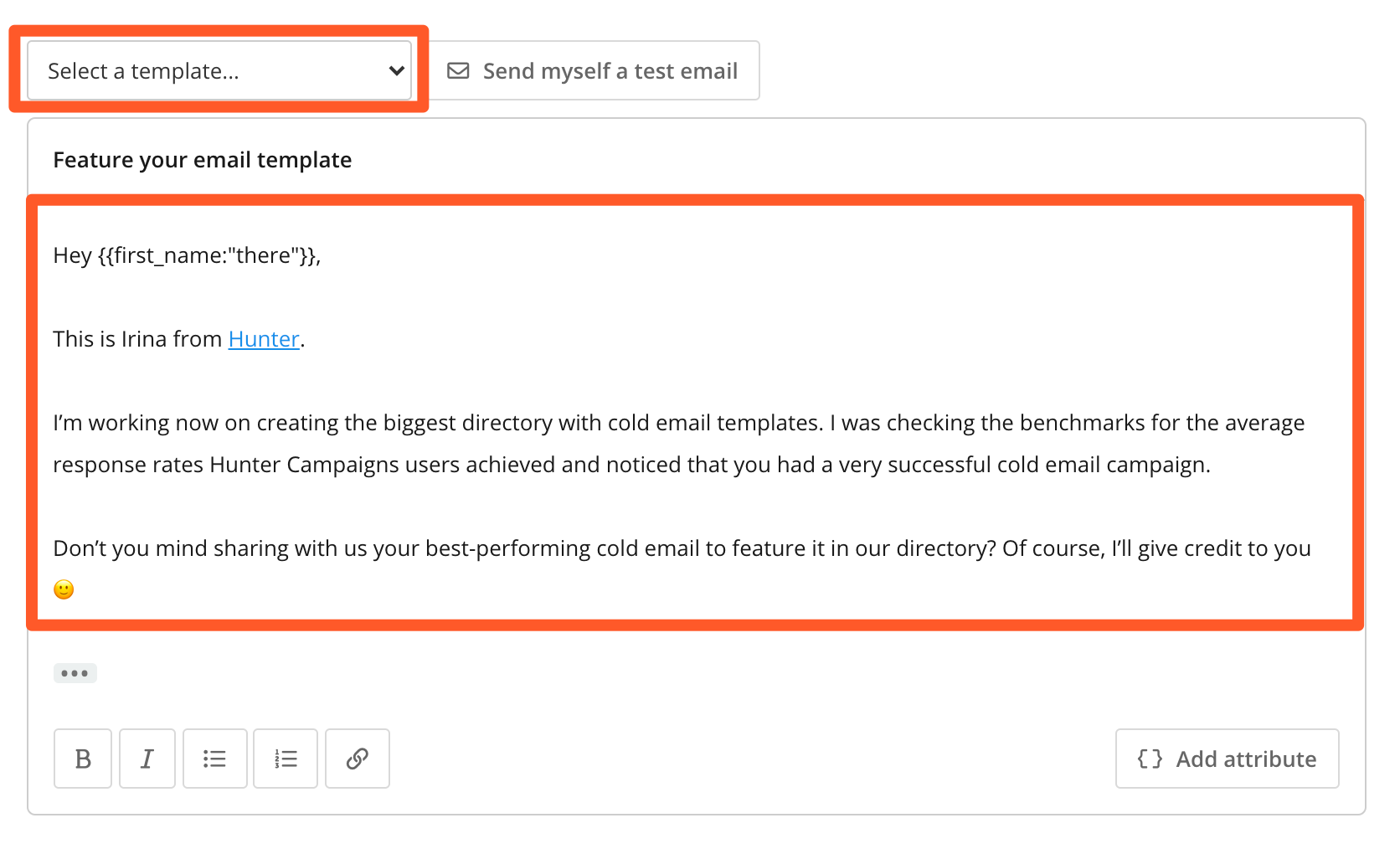
Add custom attributes into the email body and subject line that are automatically filled when sending the email based on your lead’s information.

3. Add a follow-up
You can add up to three follow-ups in Campaigns that will be sent if a recipient hasn’t replied to your first email. You can also set a custom delay between each follow-up.
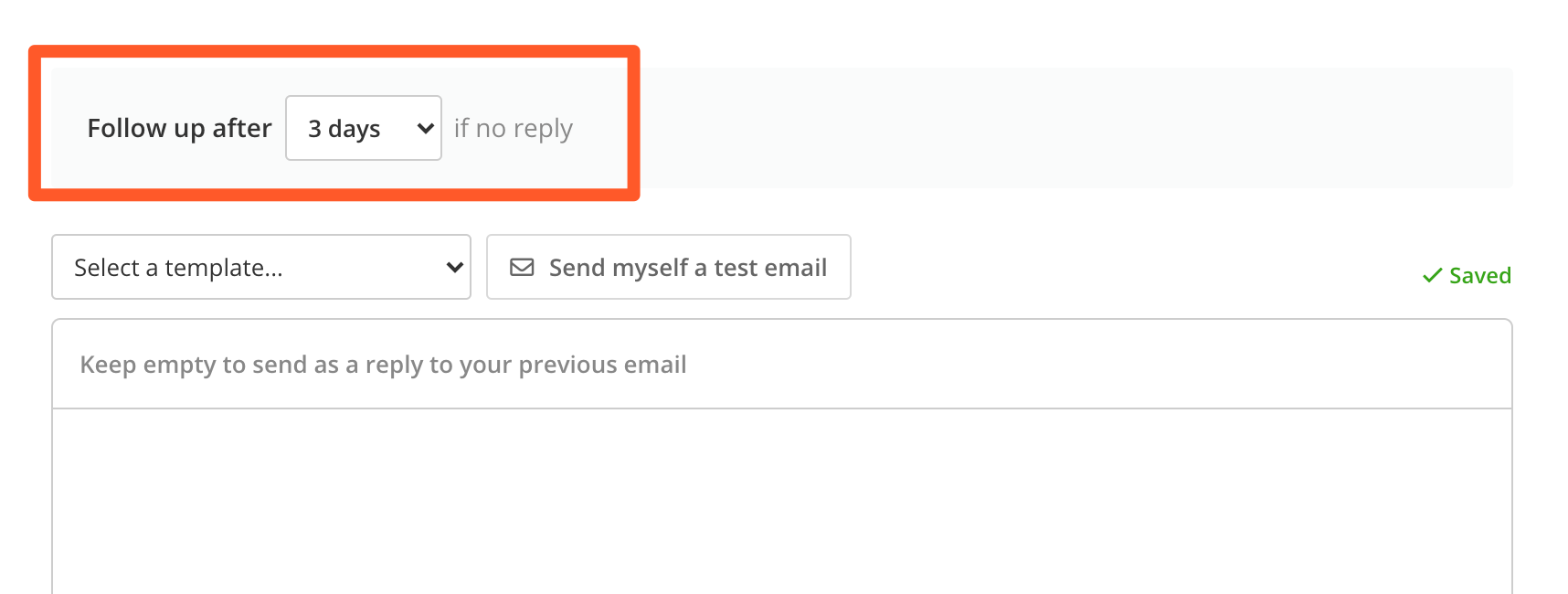
4. Add recipients
To select the target audience for the campaign, choose whether you want to:
- use the leads saved in your Leads section;
- upload a list of contacts in .CSV format;
- manually enter a list of email addresses that you want to send the campaign to.

5. Review your campaign
In the Review step, each email can be manually edited and personalized:
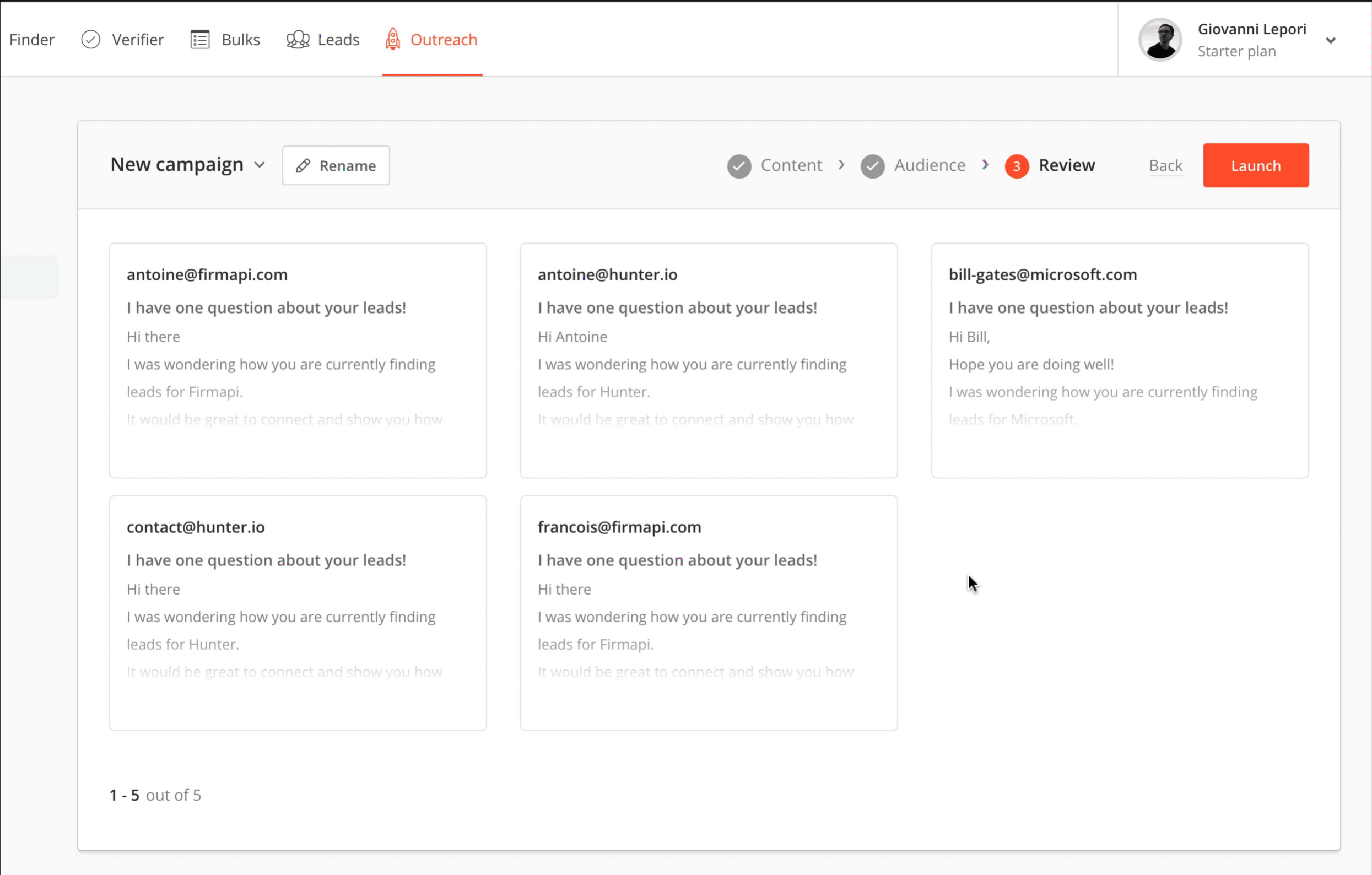
6. Monitor the campaign’s performance
Once you launch your campaign, you can easily monitor its performance in the Statistics section of the selected campaign.
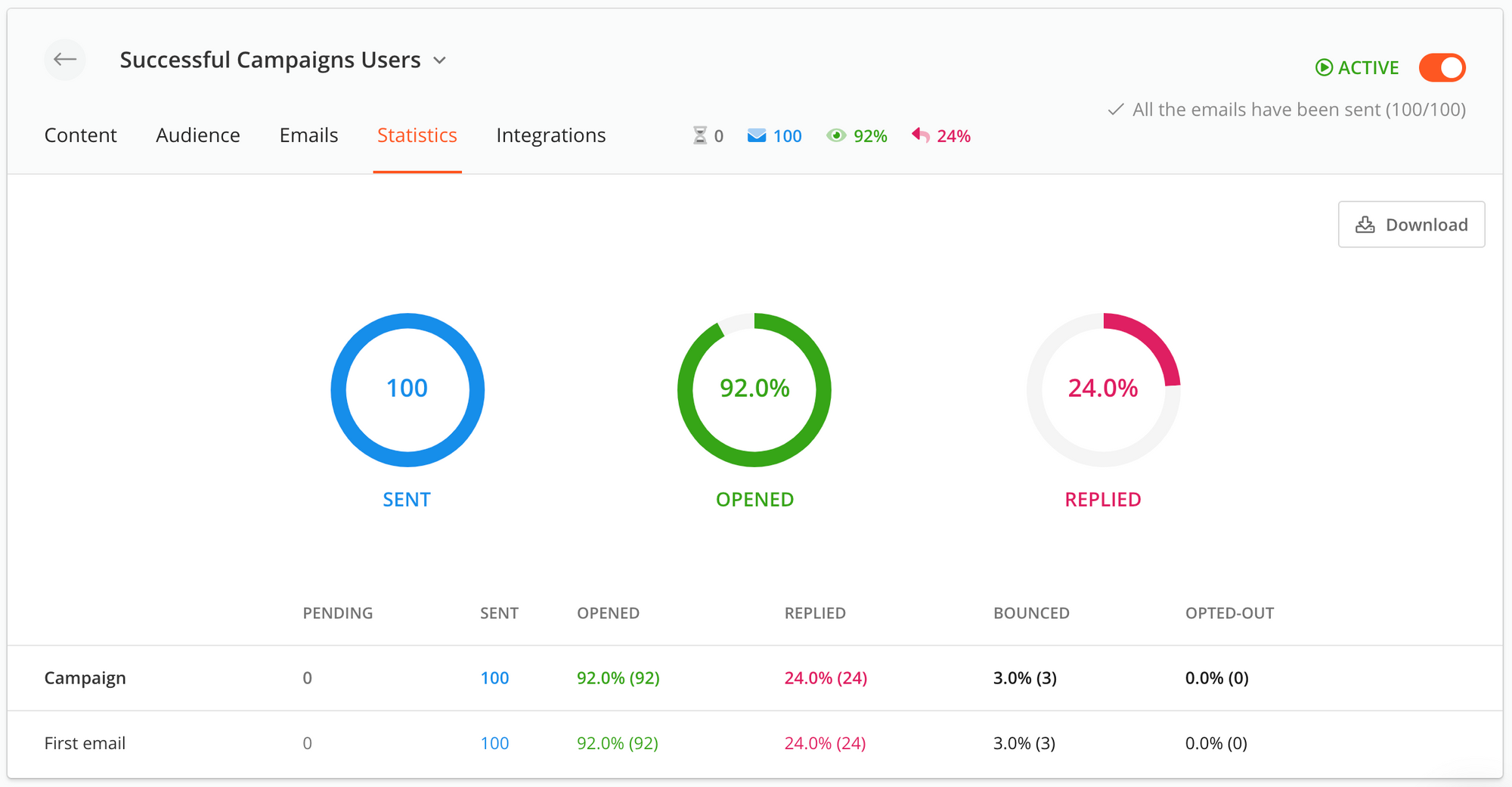
Wrap up
Writing a cold email that converts isn't an easy task since it’s quite difficult to initiate a conversation with someone who’s never heard about you or your business.
While sending cold emails, make sure that your offer is relevant to your prospects, personalize the message, write like a human, and structure the content in a way that your prospects can’t resist replying back to you.




 Send cold emails with Hunter
Send cold emails with Hunter